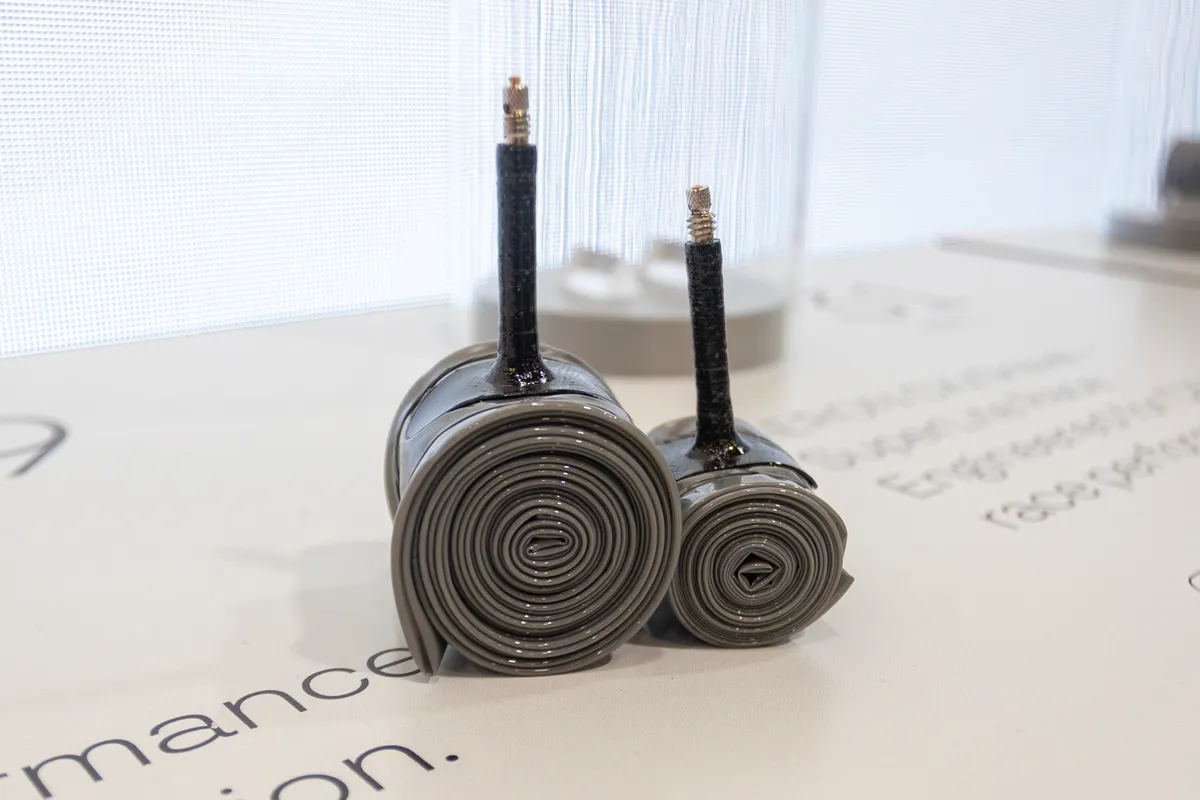Our dogs are barking after three days of traipsing through Eurobike’s expansive halls but our resolve to bring you the hottest tech from the world’s biggest cycling show remains steadfast.
In our final roundup from the show, we’re pleased to bring you a whopping 14 new, weird and wonderful tech highlights from manufacturers big and small.
And if that isn’t quite enough, check out our roundups from days one and two.
Exposure debuts Mesh technology

Exposure Reflex-equipped mountain bike lights use highly sensitive thermisters and accelerometers to control light output.
Working in conjunction, these detect small dips in ambient temperature and movement.
A drop in ambient temperature alongside fast movement suggests a rider is riding fast on technical terrain. If it detects this, the light increases power to help light the way.
Conversely, an increase in ambient temperature and reduction in movement signals the rider has likely stopped. Light power will then decrease.

While effective, this tech is bulky, so it’s limited to Exposure’s bar-mounted lights.
Exposure’s new Mesh technology enables larger Reflex-equipped lights to communicate with it’s lighter helmet lights, adjusting their power in tandem with the bar-mounted light.
This, Exposure says, increases overall power, as the lights can be run at higher power for short periods – something that wouldn’t be possible with manual control as it risks burning out the LED if run at high power for extended periods.
USE brings Vybe suspension stem to market

The Vybe suspension stem joins USE’s long-standing suspension seatpost of the same name.
Designed primarily for gravel riders, the Vybe ships with four different elastomers.

Rider weight should be used as the initial starting point when selecting these. Further adjustment can be made via two preload adjusters.
These screws can be adjusted to alter the stem’s angle by approximately 7 or 8 degrees.
Abus’s indicator-equipped Hyp-E helmet

The Abus Hyp-E is a fully-featured urban helmet designed primarily for e-bike riders.
The helmet features a removable visor, brake and indicator lights, adjustable vents and optional ear covers.
The indicators are actuated via a handlebar-mounted remote. The optional brake light is activated by a sensor that slips onto a brake lever.
The helmet is NTA-certified (a higher level of helmet safety certification for electric bike riders).
Though less frequently seen in the UK and US, Abus says it has seen significant uptake of visor-equipped electric bike helmets in France and elsewhere in continental Europe.
Enduo’s longevity-boosting skip tooth chainring

Enduo claims its skip tooth chainring improves drivetrain efficiency or longevity depending on whether its tooth profile is designed to engage with a chain’s inner or outer plates.
The pictured chainring is designed to extend longevity, with the narrow-wide-like teeth meshing tightly with the outer plate rollers of a chain.
It’s designed to fit existing mountain bike, eMTB or gravel bike cranks, though this design is only compatible with singlespeed chains (and, by extension, hub gear-equipped bikes).
Enduo claims its testing has shown the chainring can last up to 12,000km – up from 4,000km compared to an unspecified competitor chainring.
Enduo hasn’t tested the chainring design on multi-gear drivetrains.
The brand expects the chainring will be available towards the end of this year, with pricing TBC. However, Enduo says it’s long-term goal is to license its technology to existing drivetrain manufacturers.
Prologo’s unusual carved-out Tgale TT saddle

The new Prologo Tgale TT saddle has been designed with feedback from Fillipo Ganna and Josh Tarling – two of the world’s most successful time triallers.
The new saddle features an unusual dipped rear end.
Prologo says this section of the saddle is not truly necessary, as time trial riders spend next to no time on the rear of the saddle. However, the saddle must be a certain shape to conform with UCI rules.
Berk’s super light Lupina Monocoque saddle

Slovenian carbon composite brand, Berk displayed has its recently-released Lupina Monocoque saddle on display.
This integrates the rails directly into the saddle.

The saddle gives off big next-generation jet fighter vibes, especially in the ultralight pad-free model.
With padding, Berk says the saddle tops the scales at 119g.
Due to its lightweight design, the brand has given a maximum rider weight of 100kg.
Fizik’s 3D-printed Aeris Adaptive TT saddles

Fizik launched its 3D-printed Aeris Adaptive time trial saddle at Eurobike.
The saddle is available in two models.
The long-distance version has a 55mm-wide split nose for pressure relief and stability, while the short-distance version is 45mm wide with a more conventional cutout.

Fizik says the Aeris has a flatter surface than its other 3D-printed saddles, such as the Argo Adaptive, to spread pressure evenly.
For triathletes, the Aeris comes with a link to integrate a bottle cage at the back of the saddle. Fizik says this angles the bottle for easy mounting and dismounting in transition zones.
The Aeris Adaptive is available with metal or carbon rails, costing £299.99 / $299.99 and £259.99 / $259 respectively.
Aeron’s European-manufactured TPU AirTubes

Aeron is a new TPU (thermoplastic polyurethane) inner tube brand owned by RTi Sports.
Aeron says its AirTubes are lighter, stronger, faster and more sustainable than conventional butyl inner tubes.

Aeron makes tubes for all disciplines, including city riding. The European production also means the brand can keep the price to €25.
It offers tubes in different thicknesses across all disciplines, with the thicker tubes providing greater puncture protection and the thinner tubes providing weight savings.
In terms of puncture protection, Aeron says its Superlight race inner tubes offer a similar level of protection as butyl tubes.
The world’s first carbon-neutral tyre

Many brands now aim to make their tyres more environmentally friendly, including Hutchinson, who launched the Touareg Green at Eurobike.
But the Norwegian company ReTyre claims to have produced the world’s first carbon-neutral tyre.
ReTyre says it doesn’t use anything you’d find in conventional tyre manufacturing – such as vulcanisation – but it does look to other industries for manufacturing techniques, such as injection moulding.
The tyre uses recycled and repurposed materials, including fishing nets.
Pirelli’s eco-sourced P-Zero Race FSC

Pirelli is also taking steps towards developing greener products.
Its new P-Zero Race FSC is one example. The new race tyre, used by Lidl-Trek at this year’s Tour de France, uses Forestry Stewardship Council-certified natural rubber.
The new tyre is produced in Pirelli’s Bollate factory in Italy. All tyres produced in this facility will be FSC-approved.
The switch to FSC-certified natural rubber hasn’t led to a drop in performance. In fact, Pirelli says this new tyre is 6 per cent faster and 18 per cent lighter than its previous road racing tyre.
Dare’s prototype Velocity Ace aero bike

Taiwanese brand Dare had its unreleased Velocity Ace aero bike on display.
Uno-X is racing the bike at the Tour de France, but Dare had a new colour scheme on display at Eurobike, which it says is limited to 50 framesets.

The bike has a deep head tube to help it cut through the wind. It’s dimensions are said to be right at the limit of what’s acceptable under UCI regulations.
It’s a similar story with the handlebar, which is deeper than most aero cockpits.

Dare hopes to have complete Velocity Ace bikes for sale by the 2025 season.
Also on display at Dare’s booth was its climbing bike, the Mountain Ace (MA), in the highest spec available. Called the MA AFO (short for Aficianado), the frame uses high-modulus carbon fibre from Toray.

The bike’s paintwork honours Ruth Bader Ginsburg, the supreme court judge who is a hero of Dare’s visual designer. The frame has a graphic based on Ginsburg’s jewellery, which the designer describes as armour like.
Giant teases prototype carbon balance bike

A carbon fibre balance bike was on display at Giant’s stand, with the tike bike featuring a full carbon fibre monocoque construction.
Keeping up to date with modern trends, the bike has a carbon fibre integrated cockpit, as well as carbon fibre wheels.
This bike follows Specialized’s £999 Hotwalk Carbon in 2020.
ZF enters the electric bike market

ZF’s background is in marine propulsion, robotics and locomotives, but now the brand is turning its hand to electric bike motors.
The CentriX 70 motor is designed for electric mountain, gravel and urban bikes. It produces 75Nm of torque and 400W of peak power.

A more powerful CentriX 90 is designed for mountain bike use and features 90Nm of torque with a corresponding increase in peak power to 600W.
ZF says the CentriX 90 tops the scales at 2.5kg. It’s form factor is much smaller than the majority of its rivals.
Similar to Bosch, Shimano and SRAM, ZF’s new motor is part of a full eco-system that includes a top tube mounted controller, handlebar display and mode selector.
Stijn Cycles’ unusual 20in Peg road bike

Stijn was displaying its Peg road bike on the ply-lined island of Eurobike’s large handmade section.
With 20in wheels, the Peg could be mistaken for a folding bike, but the designers say the smaller wheel size was chosen to make storing the bike easier at home.
The handlebars can be turned around to shorten the wheelbase even further.
Stijn says the Peg weighs 7.9kg when specced with a Shimano Ultegra groupset.


